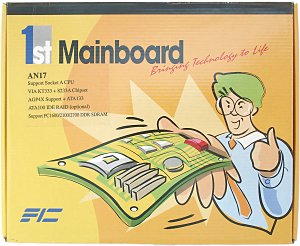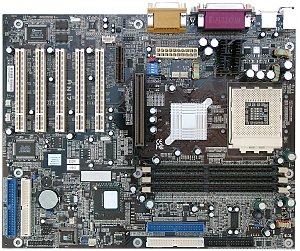FIC AN17 (VIA KT333) Mainboard
|

This product is typical of the company: it has a minimum set of functions;
the only unusual thing is black varnish of the PCB. The board doesn't differ
much from the KT266A based solution.
Accessories:
-
Package: standard design;
-
Documentation: user manual in English (also includes brief instructions
in German, Spanish, French, Chinese and Japanese);
-
Cables: 2 ATA66/100/133 and FDD;
-
Bracket with two USB ports;
-
2 CDs with software including:
-
drivers;
-
Audio Alert II;
-
Clockometer;
-
LogoGenie 2.1;
-
Media Ring Talk 99;
-
Norton Antivirus 2000;
-
Norton Ghost;
-
Norton Virtual Drive;
-
Appio;
-
AutoSave;
-
X-Stop;
-
Cute Dialer;
-
ImageMore;
-
Adobe Acrobat Reader.

The layout is good; but there are some downsides: audio-ins are between
PCI slots, the power connector is between the AGP and the rear panel, and
the position of the IDE RAID connectors can make problems for installation
of full-size PCI cards. It can be difficult to reach some jumpers when
the board is already installed. Their functions are shown on the textolite.
The 2-channel switching voltage regulator incorporates 8 capacitors
of 2200 uF.
The following controllers are integrated:
-
audio controller based on the Avance Logic ALC201A AC'97 codec with a connector
for front audio-outs;
-
IDE RAID controller based on the Promise PDC20265R supporting RAID arrays
Level 0 and Level 1 with up to 4 devices via the ATA100 protocol.
Non-unsoldered connectors: none.
The system monitoring is supported by the Winbond W83627HF-AW chip.
What is controlled:
-
processor voltage, +3.3, +5 and +/-12 V, VBAT and +5 V Standby;
-
speed of 2 fans;
-
temperatures of the processor (a built-in sensor) and the board (a built-in
sensor).
There are 2 connectors for adjustable and 1 for unadjustable connection
of fans.
Brief characteristics of the board: memory slots - 3 DDR SDRAM;
expansion slots - AGP/ 5 PCI/ AMR; I/O ports - 2 COM/ LPT/ 2 PS/2/ 4 USB
1.1; dimensions - 305x245 mm.
Adjustment can be carried out with:
| jumpers and switches |
Jumper to clear up the CMOS |
|
| Jumper to choose a FSB frequency |
100/133 MHz |
| Switches for setting processor's supply voltage |
Auto or 1.475-1.85 V in 0.025 V |
| Jumper for IDE RAID modes |
ATA100/RAID |
| Jumper for choosing a processor's type |
<1.4 GHz / >=1.4 GHz / ratio unlocked |
| BIOS based on the 6.00PG version from Phoenix-Award |
Setup of memory timings |
+ |
CAS Latency, Bank Interleave, Precharge to Active, Active to
Precharge, Active to CMD, DRAM Queue Depth, DRAM Command Rate |
| Setup of memory frequency |
+ |
By SPD, 100, 133 and 166 MHz |
| Setup of AGP bus |
+ |
|
| Setup of PCI bus |
+ |
|
| Changeable scaler of AGP and PCI buses |
- |
|
| Manual assignment of interrupts |
+ |
|
| Changeable FSB frequency |
+ |
100, 102, 105, 110, 115, 117, 120, 126, 130, 133, 136 and 166
MHz |
| Changeable CPU multiplier |
- |
|
| Changeable core voltage |
- |
|
| Changeable memory voltage |
- |
|
| Changeable chipset voltage |
- |
|
| Changeable AGP bus voltage |
- |
|
We used the latest available version of the BIOS - VHB407.
High quality and a relatively low price are the main trumps of this
and other boards of the company; but it doesn't have brilliant functionality
or overclocking settings.
Test results:
Write a comment below. No registration needed!
|
|
 |
|
|
|


